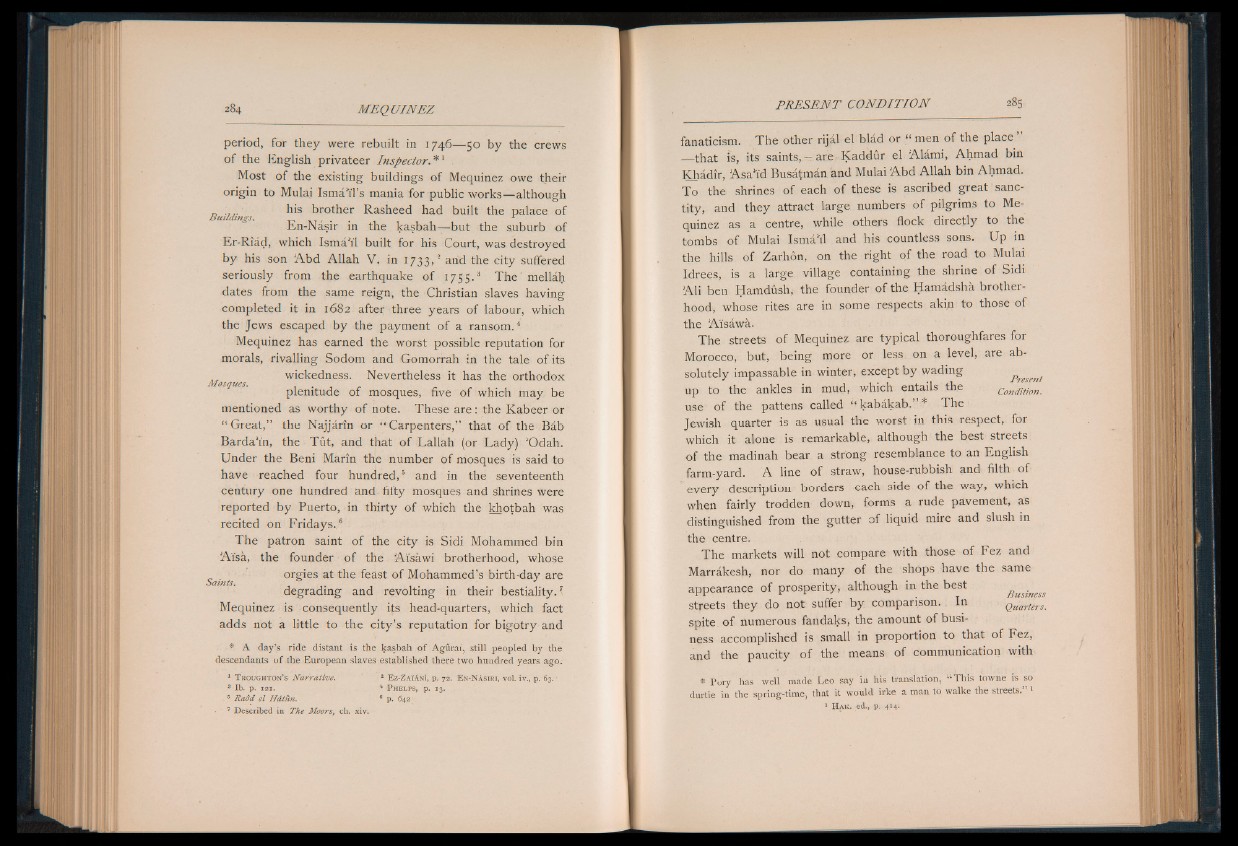
period, for they were rebuilt in 1746— 50 by the crews
of the English privateer Inspector. * 1
Most of the existing buildings of Mequinez owe their
origin to Mulai Isma'il’s mania for public works— although
; his brother Rasheed had built the palace of Buildings. *
En-Nasir in the kasbah— but the suburb of
Er-Riad, which Isma‘i'1 built for his Court, was destroyed
by his son Abd Allah V. in 1733»2 atlld the city suffered
seriously from the earthquake o f 1755.3 The'mellah
dates from the same reign, the Christian slaves having
completed it in 1682 after three years of labour, which
the Jews escaped by the payment of a ransom.4
Mequinez has earned the worst possible reputation for
morals, rivalling Sodom and Gomorrah in the tale of its
wickedness. Nevertheless it has the orthodox
Mosques. .
plenitude of mosques, five of which may be
mentioned as worthy of note. These a re : the Kabeer or
“ Great,” the Najjarin or “ Carpenters,” that of the Bab
Barda’in, the Tut, and that of Lallah (or Lady) 'Odah.
Under the Beni Marin the number of mosques is said to
have reached four hundred,5 and in the seventeenth
century one hundred and fifty mosques and shrines were
reported by Puerto, in thirty of which the khotbah was
recited on Fridays.,6
The patron saint of the city is Sidi Mohammed bin
Ai'sa, the founder of the Ai'sawi brotherhood, whose
orgies at the feast of Mohammed’s birth-day are
Saints.
degrading and revolting in their bestiality. ^
Mequinez is consequently its head-quarters, which fact
adds not a little to the c ity ’s reputation for bigotry and
. ’ * A day’s ride distant is the kasbah of Agurai, still peopled by the
descendants of the European slaves established there two hundred years ago.
1 T r o u g h t o n ’ s Narrative. 2 E z - Z a i a n i , p . 7 2 . E n - N a s i r i , v o l . i v . , p . 63. •
3 lb. p . 1 2 1 . 4 P h e l p s , p . 1 3 .
- 5 Rood e l H d t u n . 6 p . 6 4 2 •
7 Described in The Moors, ch. xiv.
fanaticism. The other rijal el blad or “ men of the place
— that is, its saints,.— are Kaddur el Alami, Ahmad bin
Khadir, A sa ’i'd Busatman and Mulai Abd Allah bin Ahmad.
To the shrines of each of these is ascribed great sanctity,
and they attract large numbers of pilgrims to Mequinez
as a centre, while others flock directly to the
tombs of Mulai Isma‘i'1 and his countless sons. Up in
the hills of Zarhon, on the right of the road to Mulai
Idrees, is a large, village containing the shrine of Sidi
A li ben Hamdush, the founder of the Hamadsha brotherhood,
whose rites are in some respects aki,n to those of
the Ai'sawa.
The streets of Mequinez are typical thoroughfares for
Morocco, but, being more or less on a level, are absolutely
impassable in winter, except by wading p resent
up to the ankles in mud, which entails the condition.
use of the pattens called “ kabakab.” * The
Jewish quarter is as usual the worst in this respect, for
which it alone is remarkable, although the best streets
of the madinah bear a strong resemblance to an English
farm-yard. A line of straw, house-rubbish and filth of
every description borders each side of the way, which
when fairly trodden down, forms a rude pavement, as
distinguished from the gutter of liquid mire and slush in
the centre.
The markets will not compare with those of Fez and
Marrakesh, nor do many of the shops have the same
appearance of prosperity, although in the best Business
streets they do not suffer by comparison. In Quarters.
spite of numerous fandaks, the amount of business
accomplished is small in proportion to that of Fez,
and the paucity of the means of communication with
•* P u iy has well made Leo say m his translation, “ This towne is so
durtie in the spring-time, that it would irke a man to walke the streets. 1